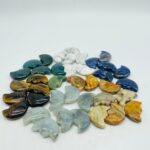Introduction
The allure of crystals has captivated humanity for centuries, with their vibrant beauty and purported metaphysical properties. Whether you’re a seasoned collector or a curious novice, identifying crystals accurately is essential to understanding their potential benefits and making informed choices.

This comprehensive guide will empower you with the knowledge and techniques to confidently identify crystals. We’ll cover everything from the basics of crystallography to advanced identification methods, providing you with the tools to explore the enchanting world of gemstones.
Crystallography Basics
Crystals are solids with an ordered, periodic arrangement of atoms or molecules. Their unique properties arise from their internal structure, which is reflected in their external forms, known as crystal habits.
Crystal Habit
The crystal habit refers to the specific shape and form of a crystal. Some common habits include:
- Prismatic: Long, thin crystals with parallel sides
- Tabular: Flat, plate-like crystals
- Pyramidal: Crystals with triangular or pyramidal faces
- Cubic: Crystals with square or rectangular faces
Crystal Faces
Crystal faces are the flat surfaces that define their shape. Each face corresponds to a specific plane of atoms or molecules within the crystal.
Crystal Axes
Crystal axes are imaginary lines that pass through the center of the crystal, defining its symmetry and orientation. The number and arrangement of axes determine the crystal system.
Identifying Crystals: Physical Properties
Hardness
Hardness is a measure of a crystal’s resistance to being scratched. It is determined using the Mohs scale, which ranks minerals from 1 (softest) to 10 (hardest).
Cleavage and Fracture
Cleavage refers to the ability of a crystal to break along specific planes of weakness. Fracture, on the other hand, is irregular breakage that occurs in any direction.
Color
Crystal color is influenced by the presence of impurities or structural defects. It can provide valuable clues for identification, as certain colors are characteristic of specific minerals.
Transparency
Transparency refers to the ability of a crystal to transmit light. It can range from transparent (completely clear) to opaque (completely blocking light).
Advanced Identification Methods
Optical Properties
- Refractive index: A measure of how much light bends when passing through a crystal
- Double refraction: The splitting of light into two rays when passing through certain crystals
Spectral Properties
- Absorption spectra: Dark lines or bands that appear when light is passed through a crystal
- Fluorescence: The emission of light after absorbing it from another source
Thermal Properties
- Thermal conductivity: A measure of how well a crystal conducts heat
- Melting point: The temperature at which a crystal melts
Crystal Identification Techniques
Visual Inspection
Using your eyes and a magnifying glass, observe the crystal’s shape, color, luster, and any visible inclusions.
Physical Testing
Perform hardness, cleavage, and fracture tests to gather further information.
Optical Analysis
Use a refractometer to measure the refractive index or a spectrometer to analyze absorption spectra.
Thermal Analysis
Conduct thermal conductivity and melting point tests to characterize the crystal’s thermal properties.
Applications of Crystal Identification
Crystal identification plays a crucial role in various fields, including:
- Geology: Identifying minerals in rocks and soil
- Archaeology: Dating and classifying artifacts
- Jewelry: Authenticating gemstones and determining their value
- Medicine: Developing therapeutic applications for crystals
- Energy: Exploring the potential of crystals in renewable energy sources
Modern Approaches in Crystal Identification
Spectrofluorometry
This technique uses a spectrophotometer to analyze the fluorescence spectra of crystals, providing detailed chemical and structural information.
Raman Spectroscopy
Raman spectroscopy utilizes the inelastic scattering of light to identify molecular vibrations and chemical bonds within crystals.
X-ray Diffraction
X-ray diffraction involves bombarding crystals with X-rays and analyzing the resulting diffraction pattern to determine their crystal structure.
Artificial Intelligence
Machine learning and artificial intelligence algorithms are being developed to automate and improve crystal identification processes.
Conclusion
Identifying crystals is a fascinating and rewarding endeavor that unlocks the door to their potential benefits and applications. Through a combination of physical properties, optical analysis, and advanced techniques, you can confidently identify gemstones and explore the enchanting world of crystals.




























